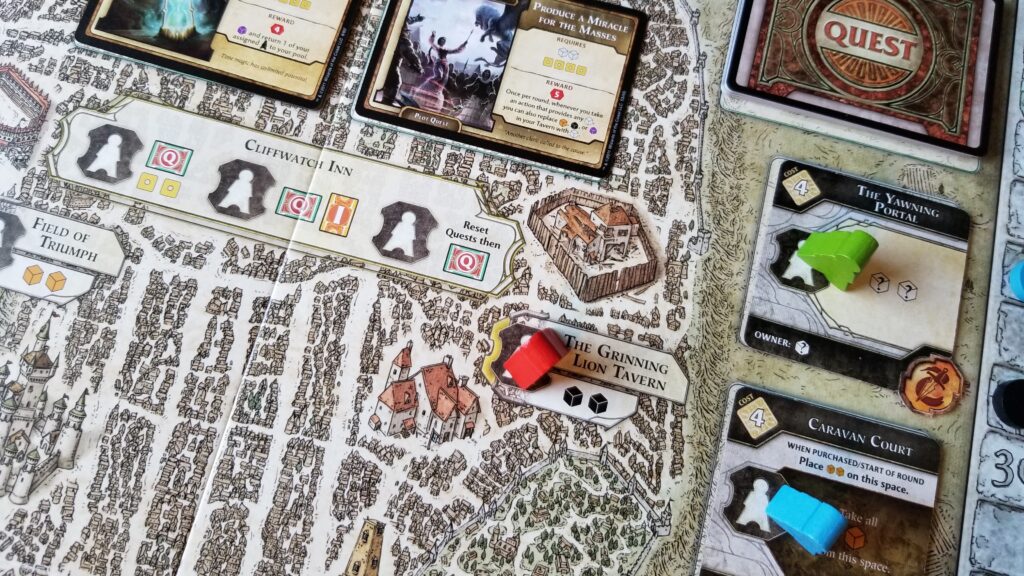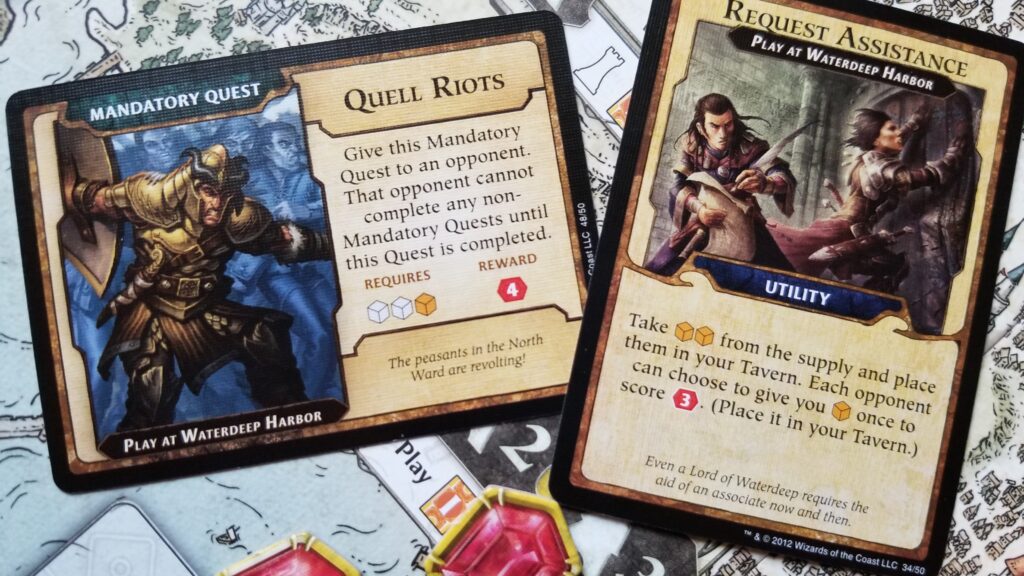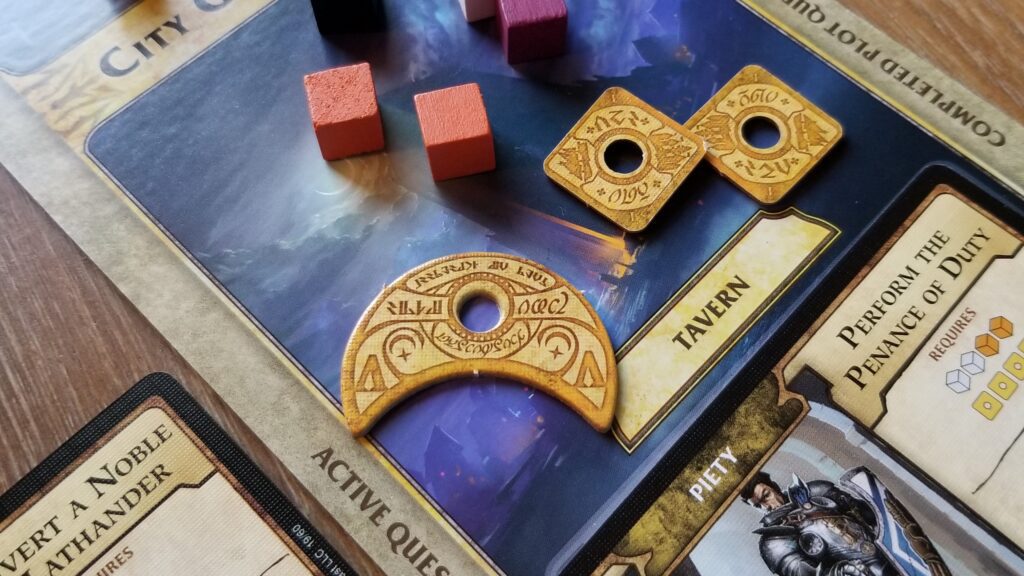
Lords of Waterdeep is a 2012 board game published by Wizards of the Coast. Waterdeep? Wizards of the Coast? Wait…is this a Dungeons & Dragons game? Well yes, but actually no. True, the game is set in the City of Splendors of the Forgotten Realms, but there is no role-playing to be found here. Look past the veneer of epic fantasy and you have…a very nice worker placement strategy game. Indeed, the game will appeal to your Catan friends far more than your fellow adventurers and dungeon master.
At its core, Lords of Waterdeep is a simple game. Each round, players take turns placing their agents (workers) on open locations in the city. This recruits adventurers (resources) or acquires gold from that location. Each location provides different resources, and two players cannot use the same location during the same round. Thus, as the round goes on, options for recruiting adventurers grow more limited. A round concludes when all agents are placed. Victory points are obtained by completing quests. During the course of the game players obtain Quest cards, each of which specifies some combination of adventurers and gold necessary for completion. After placing an agent, a player may opt to finish a quest by returning the requisite number of adventurers and gold to the “bank”. The game lasts a total of eight rounds, and the player with the most victory points at the end of the game wins. It does not take long for players to grasp the basic concept—place an agent, collect adventurers, complete a quest, score points—and the rounds tend to flow at a brisk pace.

There is a level of strategy involved with prioritizing quests and agent placement, but Lords of Waterdeep provides additional layers of depth, both economic and machiavellian. For example, each round a player may purchase one of the three available buildings from Builder’s Hall and place it in the city proper. These buildings are just like any other location in the city, but usually grant better resources or bonuses. Simply constructing a building could grant a few victory points, but its true value comes from its availability in Waterdeep—if another player uses one of these buildings, the owner also receives adventurers, gold, or victory points. Thus, placing a useful building early could be highly lucrative for a player.
The quests themselves come in a variety of types, such as Skullduggery or Commerce or Piety. The quest type matters little except that each player’s secretly drawn Lord of Waterdeep card reveals a pair of affinities that determine extra victory points at the end of the game. Piergeiron the Paladinson, for example, will gain an extra 4 victory points for each Piety and Warfare quest completed during the course of the game. Thus, it definitely behooves the player to be discerning in his or her quest selection, if possible. Furthermore, some special “plot quests” bestow fewer victory points, but instead grant ongoing bonus effects. The final result is that a player’s pursuit of specific quests has a tangible impact on the outcome of the game.
The game also has Intrigue cards. A player may defer placing an agent until the end of the round in order to play an Intrigue card, which has a variety of possible effects. Some grant useful bonuses, such as allowing the player to double-up on a location or granting immediate access to adventurers. Some are attacks, such as stealing adventurers from other players or forcing an opponent to complete a mandatory quest. All in all, Intrigue cards add a level of variety and competitiveness to each game, and, when used wisely, they can turn the tide. They perfectly encapsulate the theme of playing as a secretive, scheming Lord of Waterdeep.

And the theme does enhance the game, should the players embrace it. After all, as a Lord of Waterdeep, wizards, clerics, fighters, and rogues await your command. Your entrepreneurial endeavors fill your coffers with gold and jewels. You can send fighters and rogues to Spy on the House of Light, or you can force your rival on a time-wasting mission to Stamp Out Cultists just as he is beginning to gain power. The art and pithy quotes on the game cards are well done and further add to the experience, and the game board is large and nicely detailed with cluttered city roads and fanciful fantasy names like “Blackstaff Tower” or “The Grinning Lion Tavern”. Still, players can just as easily ignore the fantasy elements and simply focus on collecting purple, white, orange, and black cubes to exchange for points.
Most matches I have played have fallen somewhere in between. The fantasy elements are appreciated and coyly referenced, but ultimately everyone is just enjoying a game night and no one expects it to be a D&D campaign. In that sense, Lords of Waterdeep hits a sweet spot of geeky fun, and while the strategy is satisfying the game is also accessible. The box indicates it is recommended for 2-5 players ages 12+, but I have played it with my pre-teen kids and they had a blast. Even my wife, who dislikes board games, got into the competitive spirit and has played multiple times. I have also played the game with some buddies from church, and a jovial time was had by all. Scythe is a staple with that crew, and so Lords of Waterdeep certainly appeals to a broad spectrum of players.
On a practical level, the wooden game pieces are quality, and the cardboard building cards, owner markers, gold, and victory point jewels are thick and sturdy. I especially like the little notch in each building card that awaits the owner’s sigil—a nice touch—and the design of the gold pieces. The intrigue and Quest cards do not feel overly cheap. Even the unique shape of the box is handsome and a tad fantastical. Inside the box, everyone who purchases the game will appreciate the organization of the game pieces.

Lords of Waterdeep is a nice strategy game that can be played with both family and friends. Not too long, nor lacking depth, it is a solid choice for a game night. Recommended.
Scoring – 80%
Gameplay: 4/5
Setting: 4/5
Art: 4/5
Components: 4/5
Replayability: 4/5
Morality/Parental Warnings
The gameplay itself is a classic worker placement game, but it does take place in the Forgotten Realms campaign setting of Dungeons & Dragons. As such, there are references to magical story elements such as orcs, wizards, vampires, fantasy gods, and the like. The world is populated by both heroes and villains, and the Quest and Intrigue cards reflect this—some are noble (like battling monsters or forming alliances), while others are nefarious (like thievery, bribery, or assassinations). Box art features a woman with shapely armor.
